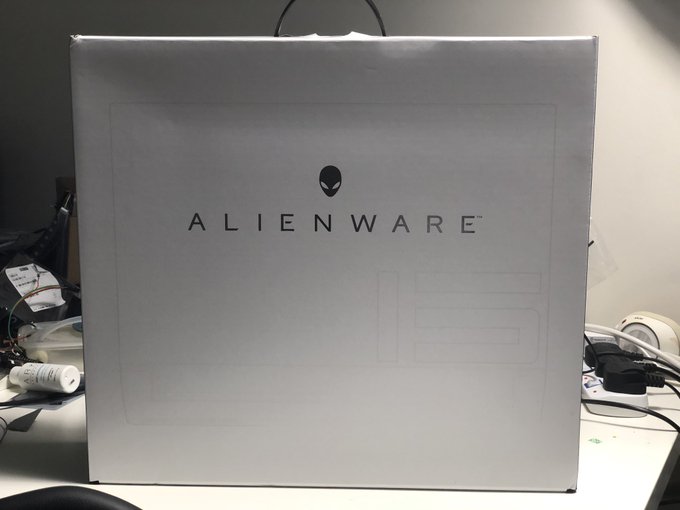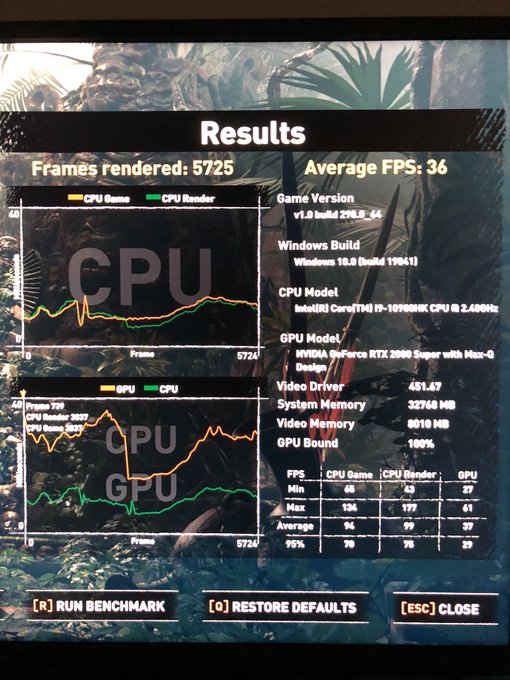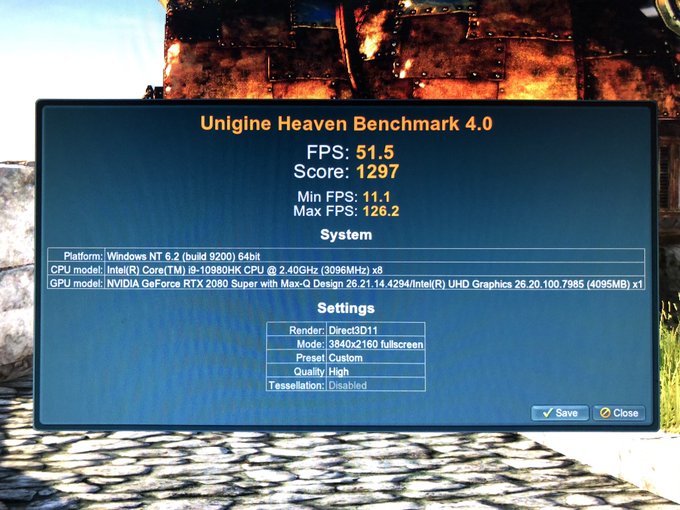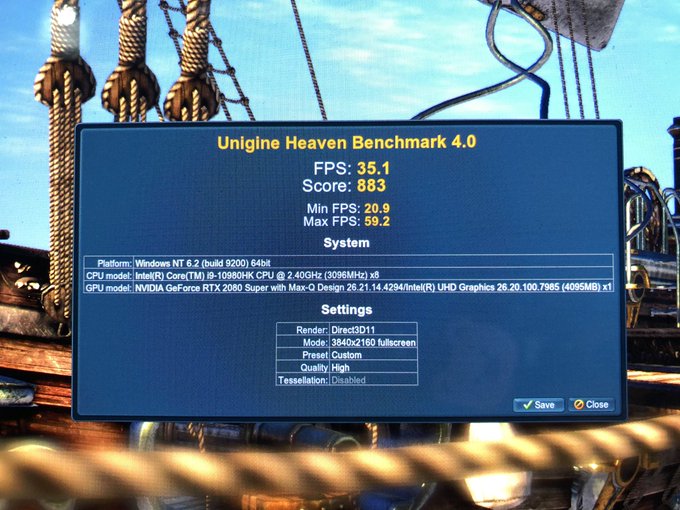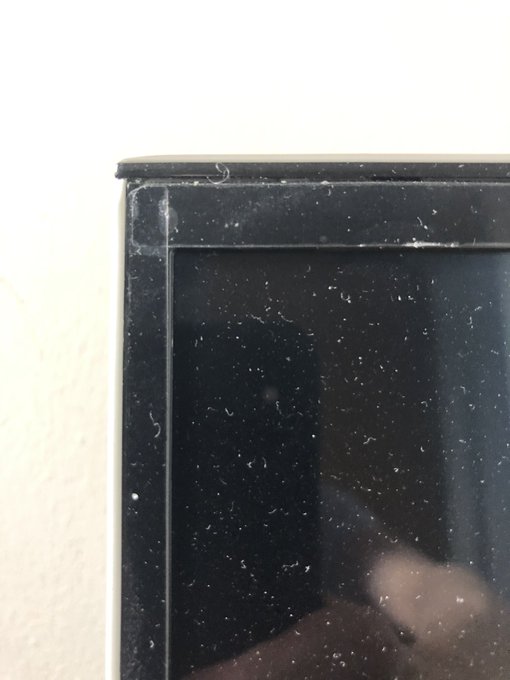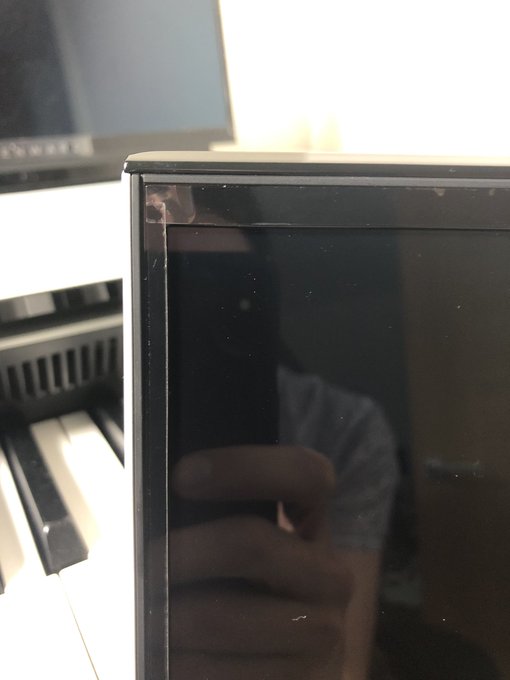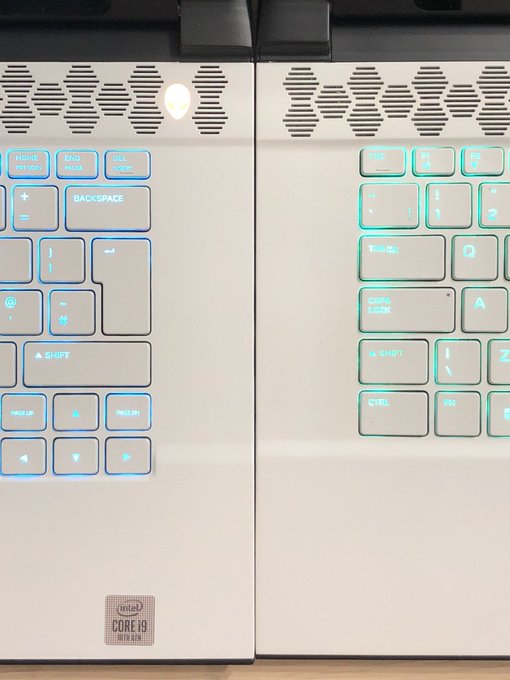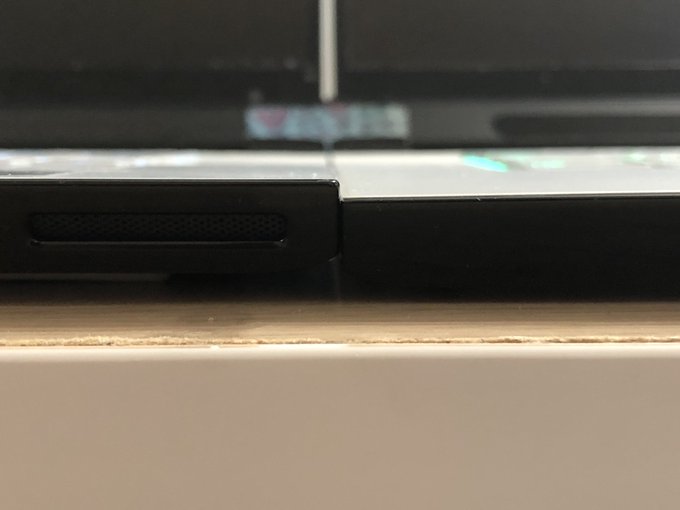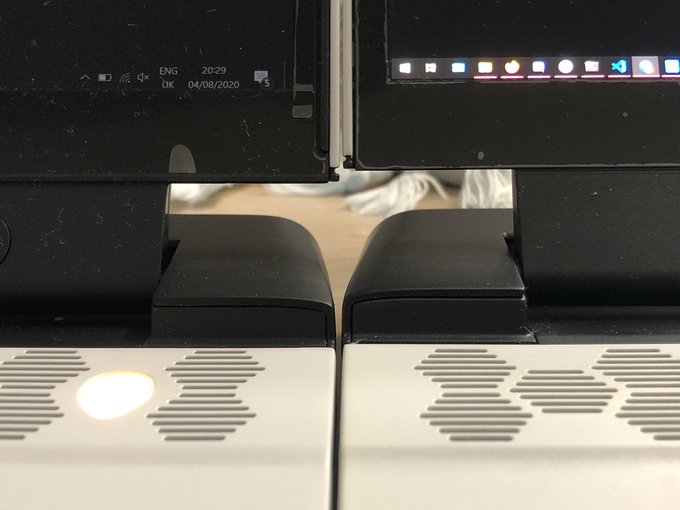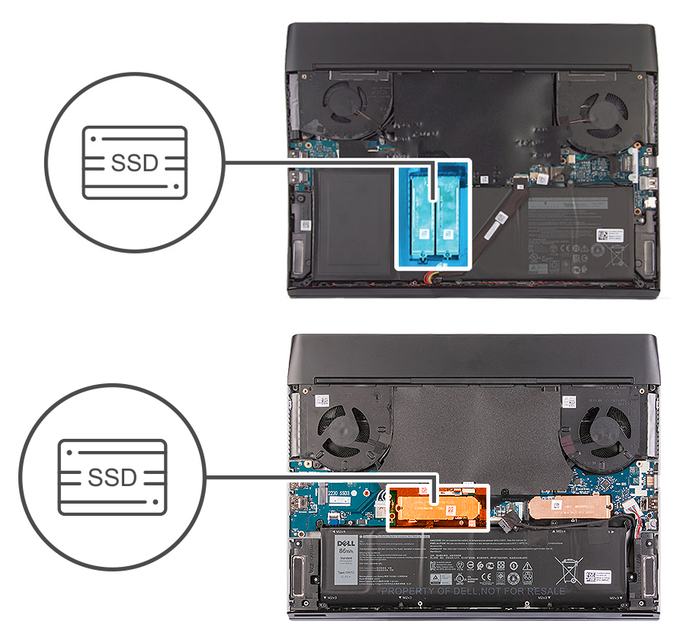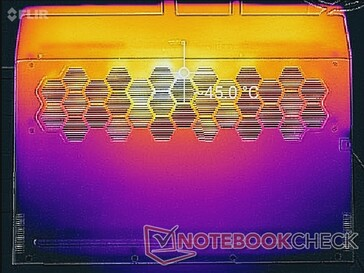Alienware m15 r3 vs r2 Showdown
I’ve had the Alienware m15 r2 as my daily-driver for around a year now- using it for a mix of work, Blender tinkering, musical noodling and gaming. It’s a solid machine and is as much at home as a portable workstation as a gaming laptop, and I appreciate being able to have a powerful CPU and GPU combination with me wherever I might go.
Factory fresh! pic.twitter.com/VGNfd30ele
— Phil Howard (@Gadgetoid) July 21, 2020
The r2 has some flaws, however, and the r3 seeks to address those blow-by-blow bringing Alienware’s ultra-compact gaming offering one step closer to perfection.
After a few weeks of tinkering with the r3 I’ve found a lintany of improvements over the r2, some of which make a considerable improvement to my daily workflow. This article is part review and part showdown between the r2 and r3. I wont go in-depth with benchmarking for the sake of benchmarking because, frankly, I don’t give a damn. Most benchmarks shown below have been performed stock with no optimisations and no attempt to eke more performance out of these machines. I’m pretty happy with the OOB experience- albeit I do find underclocking and undervolting the r3’s i9 to be useful.
Optimus Prime
NVidia’s Optimus still remains largely a mystery to me but the crux of the technology is that it allows a laptop- like the Alienware m15 -to include both an integrated and discrete GPU, and switch between the two as the balance between demand for battery life or raw performance changes. On a desktop PC you’d simply run everything through the discrete GPU, but this would be horrible for battery life on a laptop so we’re left with a weird graphics switching solution that’s more known for its warts and troubles than the good it does.
One particular, highly frustrating wart with Optimus has been its interactions between the discrete-GPU connected 4K OLED in the r2 and r3 and professional apps like Blender- Blender does not like switchable graphics. Not in a “everything breaks horribly kind of way” but in a “the screen subtly dims or brightens when interacting with Blender” kind of way.
On the Alienware m15 r2 any interaction with Blender will cause Blender to dim very slightly, and as soon as the interaction stops it will snap back to its brighter state. This change is extremely subtle, but absolutely infuriating once you notice it.
On the Alienware m15 r3 interacting with Blender will, again, cause the screen to dim very slightly, but this time it takes a few moments for it to return to its brighter state once that interaction stops. This is decidedly less infuriating than before, but still very noticable.
Insofar as I can tell this issue is caused by the graphics switching from integrated to discrete when Blender is interacted with. This has been reported by users to NVidia, Intel and various laptop manufacturers with each passing the buck to the other in an endless and fruitless cycle of frustration.
Fortunately users have observed it’s possible to fix this simply by pushing Blender into full-screen mode- but if you don’t want to dedicate your entire screen to Blending then it’s a poor compromise.
The *crucial* difference between the m15 r2 and m15 r3, however, is that the r2 exhibits this behaviour on external displays. The r3 does not.
Indeed just by looking at the graphics control panels on the r2 compared to the r3 show that internal system changes are now connecting external displays not to the integrated GPU, but apparently directly to the discrete one. It’s interesting to note that this same issue affects videogame framerates.
The Curious Case Of The Missing Frames
In multiple benchmarks using Shadow of the Tomb Raider I found myself with an issue of mystery missing frames. Those frames turned out to be hiding in an external monitor- or to be less obtuse connecting an external 4K monitor to the Alienware m15 r3 and running SoTR through that monitor instead of the internal 4K display gave me something like a 15% boost in framerate over the internal display.
This same benchmark on the internal display flushes about 15% of the frame rate down the toilet ? pic.twitter.com/U9rABsPdvi
— Phil Howard (@Gadgetoid) July 30, 2020
Thinking I was chasing ghosts or misreading the Tomb Raider benchmarks I decided to run several consecutive Unreal Engine: Heaven benchmarks to try and confirm my findings. Now… I may be encountering a revelation that’s totally known to laptop gamers here, but I found the different between internal and external display performance that these tests revealed absolutely staggering.
Holy shit this is way worse than I tested in SOTR- FPS tests on the Alienware m15 r3 with 4K OLED:
– external 4K display: 51.5FPS
– internal 4K display: 35.1FPSW H A T? pic.twitter.com/07adtsU2Ja
— Phil Howard (@Gadgetoid) July 30, 2020
Not only did this happen on the r3, but also the r2, a repeatable difference in performance between internal and external display of some 60%.
Since the integrated GPU should be doing nothing more than a straight framebuffer copy from the discrete GPU to its connected display, I’m frankly astonished that such a huge disparity in performance exists. Users who care about framerate should steer well clear of the 4K OLED in favour of the 144 and 300Hz 1080p displays. In a bitter twist of irony the very architecture that connects the 4K OLED destroys some of the performance required to push a decent framerate out of it at mid/high detail, making it a poor choice if you want to get the most out of gaming.
To really drive home how bad this impact is- I received a higher framerate in Unreal Engine: Heaven driving an external display from an RTX 2070 Max-Q than I did driving the internal one from an RTX 2080 Max-Q. The same happened with 3DMark TimeSpy where both the CPU score and GPU score were lower when driving the internal display, albeit not by much.
If you’re dead set on the 4K OLED for creative use, but play games even slightly more than casually then you’d be doing yourself a disservice not grabbing a 1440p 144Hz external display for gaming. For another extreme example, an external vs internal display in something like Forza Horizon 4 made the difference between the game V-Syncing at 30FPS (internal) versus 60FPS (external) in Ultra dynamic detail.
I asked a fellow m15 r3 owner on Reddit if they had an external display to confirm this, andthey went above and beyond with a detailed blow by blow of their experience and tests– including some interesting ideas about the how and why of it. Their findings revealed much less impact when driving lower resolution displays, but again at QHD resolution found instances where the internal/external display framerates were substantially different.
Now, I love the 4K OLED and it’s a stonking screen for Netflix, Blender, casual desktop use and even- despite the findings above- a whole lot of gaming, but I think it can’t be overstated how hamstrung your GPU can be when driving it.
You’ll never take our FreeSyncdom
One additional and welcome side-effect of the changes in the r3 is the ability to enable FreeSync and G-Sync (ostensibly the same thing as far as NVidia Control Panel is concerned) on external displays. Though I’m not sure if I managed to break G-Sync in my original r2 setup due to clean-reinstalling windows. Still, with the r3 irrespective of whether a display is connected via a Thunderbolt 3 to DisplayPort adapter or directly to the mini DisplayPort on the Alienware m15 r3 itself, “Set up G-SYNC” will show in NVidia Control Panel.
While my daily-drive, cheep-and-cheerful 4K Samsung LCD does actually support FreeSync, it’s only capable of 60Hz and it falls far, far short of G-Sync certification with horrendous flickering. It’s a poor test of the technology in the grand scheme of things, but it did work. I confirmed via the OSD that the framerate was variable, and observed the disappearance of screen tearing in game. This is a huge boon since it means the combo of internal 4K OLED for creativity and external 144Hz for gaming is a solid and viable setup. I will endeavour to grab some displays and test this properly in the coming months.
Rubber baby LCD bumpers and other functional tweaks
Of mild note is a new rubber bumper around the display in the r3. I’d love to speak to the support techs who had to deal with whatever issue prompted this change.
Old VS new. This change tells a story, I’ll bet. pic.twitter.com/dDu5kkKlme
— Phil Howard (@Gadgetoid) July 21, 2020
This should, in theory, better protect the display when the laptop is carried in a bag but I’ve never had any issues with my m15 r2 despite carrying it to work every day.
Along with the LCD bumpers come a handful of other minor design changes which take a close comparison to spot.
Of note is the r3s chassis falling slightly short of the r2s- to include the microSD slot (not to mention some of the internal changes) clearly necessitated a completely new design for the enclosure, so things have been subtly refined.
Found more subtle differences between the @Alienware m15 r2 and r3- it’s clear this revision was thoroughly refined.
For starters the body of the r3 seems a tiny smidge longer. pic.twitter.com/awhfjqXOYu
— Phil Howard (@Gadgetoid) August 4, 2020
And, certainly far more interestingly, the front edge of the r3 sits slightly proud of the r2- betraying a taller front-foot that presumably helps increase airflow under the laptop. This change appears to be part of a package of tweaks to improve cooling- albeit the addition of a vapour chamber is probably the one most shouted about.
Ignoring the obvious addition of speaker grilles the front foot for the r3 is about 2mm taller, giving the whole front edge that extra desk clearance for better airflow. pic.twitter.com/GO4UwWnlJ6
— Phil Howard (@Gadgetoid) August 4, 2020
The display – or perhaps the entire back edge – of the m15 r3 also sits slightly lower. This could be due to the raised front causing the whole laptop to pivot over its rear foot- but my basic knowledge of geometry suggests that wouldn’t account for a change this pronounced on its own.
The display in the r3 also sits ever so slightly lower. And there appears to be an extremely subtle change to the indentation in which the keybed sits but it’s hard to capture. pic.twitter.com/Iciqu6J2US
— Phil Howard (@Gadgetoid) August 4, 2020
The plastics around the keybed has also changed subtly, but it’s too tricky to really capture.
Charge of the Power Delivery Brigade
While the ability to power and charge the Alienware m15 r3 via USB Type-C Power Delivery seems to always earn a mention, it’s never clarified just how much of a non-feature this is. The system cannot pull power from the USB supply and the battery in tandem. Heaven benchmarks with just battery, battery + 45W and battery + 61W power adapters were so close as to be not worth comparing. In all cases increased load on the system will drain the battery even while an external supply is connected, and a 61W supply is not sufficient to keep up with anything but the lightest use.
Conducting these three benchmarks drained my battery from full to 80%, and using the 61W adapter it took about 2 hours to recover that 20% charge back to full. At the end of this charge cycle the 61W adapter (a 2016 Apple MacBook Pro supply) was *hot*. I also had to place the system into Balanced mode, rather than performance, before it would charge at all- at first it sat for about 20 minutes on 80%. Note: an 81W or 100W adapter should fare better, but it’s clear even those would be sufficient just for casual use. Since the battery life of the r3 isn’t noticably better than the r2, however, this does mean you can use Power Delivery to do some sustained light browsing without a huge, obnoxious power supply trailing across the living room.
microSD for Raspberry Pi Rescue
I thought the microSD card slot on the r3 would be a killer feature, and for some it will provide a handy way to transfer files between the laptop, phones and cameras. For me, however, my primary use-cases are flashing new Raspberry Pi OS distributions to SD cards, editing the card configuration and – occasionally – performing surgery within the Linux partition on the SD card.
Unfortunately despite Microsoft’s push forward from WSL1 (Windows Subsystem for Linux) to WSL2 (Windows Subsystem for Linux, but now it’s basically just a regular VM) it’s still extremely difficult to access EXT3/4 filesystems from Windows 10 with anything short of a full VirtualBox setup using pass-through USB. Microsoft’s WSL cannot yet do anything with USB, much less natively mount a filesystem on an external drive, and Hyper-V is no better in this regard. This, of course, isn’t Alienware’s fault but does mean I still have to lean on a second, Linux-powered laptop for some of my workflow.
Still, it’s a welcome addition and will no-doubt come to the rescue at some point in the future when I’m out and about with only my portable workstation. I did manage to BSOD my laptop ejecting a microSD card though- not quite sure what happened there.
2230- the SSD that could
Perhaps my saving grace for Linux use will be the 2230 “WWAN” PCI.e slot that’s joined the two 2280 slots in the r3. While this SSD connection is purportedly slower, it might serve well as a dual boot drive for Linux (I’ve seen people already installing and using Linux on the r3) or as additional storage for virtual machines. The downside of the 2230 SSDs is that they’re currently rather difficult to get hold of. So much so, in fact, that I’ve seen guides showing how to salvage the 2230 SSD out of a Caldigit Tuff Nano for upgrading a Surface Laptop. I reached out to Kioxia about their KBG40ZNS1T02 SSD which is a “client SSD” for business (it seems these are largely B2B parts for less readily upgradable laptops), but which may be a perfect fit for the m15 r3’s 2230 slot. Availability is pitched for somewhere in August so watch this space.
The internal changes between the @Alienware
m15 r2 and r3 are quite significant. You’ve got to wonder at the hell that the r2’s contrived battery with its nestled SSDs caused for service techs.Note the spaced out SSDs in the r3 (below) versus the cozy bays in the r2 (above). pic.twitter.com/RQX0h01oKE
— Phil Howard (@Gadgetoid) August 1, 2020
Another noticable tweak to the SSD slots in the r3 is their relocation from being nestled in the battery. Since batteries and SSDs like to get hot, and batteries can swell up and push components around, this is probably a change for the better with another tech support story behind it. Additionally the SSDs are now physically distanced from each other, so this likely helps spread potentially hot parts around the inside of the system.
Though they don’t stress the SSDs in their thermal imaging checks, I’d be damned if that’s not the outline of the r2s drive bays in the image on the right. The placement is too perfect. pic.twitter.com/3Pt0Jrca0E
— Phil Howard (@Gadgetoid) August 1, 2020
For better images of this- both regular and thermal- you can compare NotebookCheck’s bench tests for the Alienware m15 r2 and Alienware m15 r3.
Cool as a cucumber
If the extensive thermal changes- down to raising the laptop off the desk- didn’t clue you in- the m15 r3 has clearly incorporated some improvements over the r2 when it comes to cooling.
Unfortunately the intervening year hasn’t seen Intel make any improvements to their CPUs and the i9, unsurprisingly, will happily shoot up to 100c in the blink of an eye when running an all-cores stress test. I honestly don’t think it’s possible to cool either it, or the i7, perfectly in such a thin envelope.
With constant thermal throttling, however, the i9 is still an absolute monster and will happily chomp its way through anything I throw at it. Indeed the system still felt responsive while running the stress test, which suggests it might be overkill for my needs.
Although Alienware Command Center’s overclocking functionality is fairly thin on the ground, slightly confusing and somewhat broken I did manage to negotiate its awfulness to set up a -100mV undervolt and an underclock to 3.5Ghz (seems to burst at 4Ghz) for the i9. At these settings it can run a stress test all day long and sit at 80-90 degrees. This is still toasty, but a far cry from the continually thermal throttling hot mess of a untweaked GPU. Deliberately limiting the performance seems disinginuous and it’s something I never bothered doing with my i7 r2 despite the alleged thermal issues- but I’m keen to keep a lid on fan noise for general purpose workstation if I can. For gaming I’m happy to go no-holds-barred, but it’s worth noting that – while I did by no means extensively benchmark or A/B test this – I did notice a very slight improvement in TimeSpy CPU score *with* the underclock/undervolt. Perhaps consistent performance is better than oscillating at thermal throttle? Honestly, though, benchmarks aren’t my thing.
In closing
When choosing an r3 system I opted for the RTX 2080 Super Max Q, i9 and 32GB RAM. The RAM is really useful to me, since I’ve had problems before balancing my work and gaming on a single system and games like Forza Horizon 4 have historically just bailed to the desktop if they can’t allocate enough RAM. THe RTX 2080 and i9 are slightly more exuberant choices that I made more to give myself the opportunity to test the additional thermal overhead of the r3’s design. Granted the additional cores of the i9 will no-doubt be useful for some of my workloads. However I might have failed to realise just how much headroom both of these components have- as far as I understand it the 2080 – when you bring VSync into the mix – will be doing less work than the 2070
I’m really excited to get my workflow migrated over from the m15 r2 to the m15 r3. There are many small improvements that will benefit my day-to-day and the better thermal headroom should keep it running quieter for longer. I’ve got to find, fit and test some 2230 and 2280 SSDs beforehand, though, and hope I manage to get something in time for Flight Simulator 2020. It’s been a long, long time since I enjoyed Flight Simulator and while I’ll still be in over my head I hope it’ll instill some nostalgia in me.
